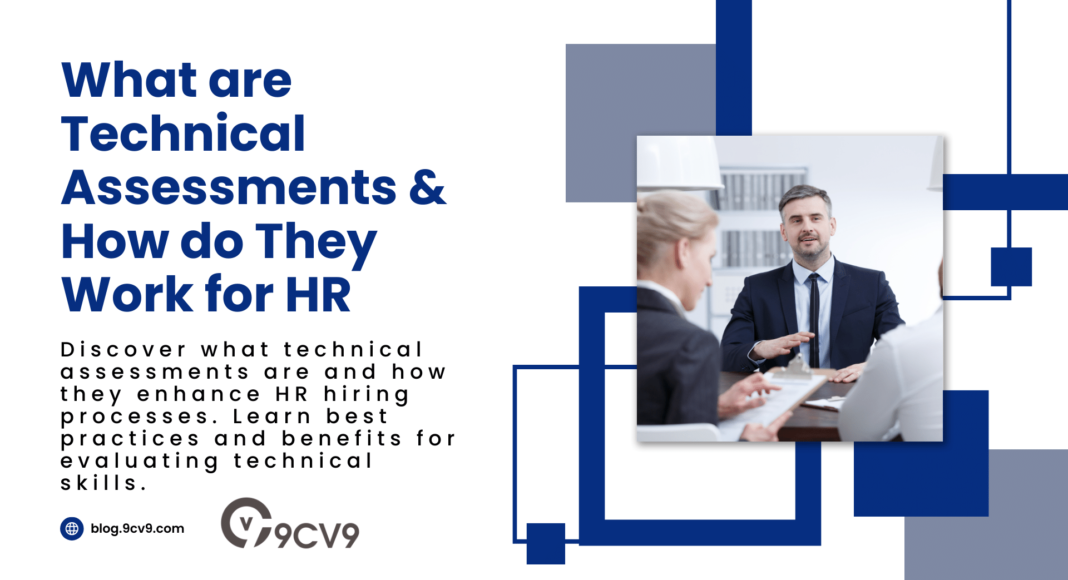Key Takeaways
- Streamline Hiring: Technical assessments optimize HR processes, enabling efficient screening and selection of top technical talent.
- Objective Evaluation: They ensure fairness and accuracy in candidate assessment, mitigating biases and promoting diversity.
- Strategic Implementation: Implementing technical assessments strategically aligns with job requirements, enhances candidate experience, and supports better hiring decisions.
In today’s rapidly evolving job market, finding the right talent has become more challenging than ever.
As companies strive to remain competitive, the demand for highly skilled professionals, particularly in technical fields, has skyrocketed.
To meet this demand, Human Resources (HR) departments are continuously refining their recruitment strategies. Among the most effective tools emerging in this landscape are technical assessments.

These assessments have transformed the hiring process, offering a robust method for evaluating a candidate’s practical skills and problem-solving abilities.
Technical assessments are specialized tests designed to measure a candidate’s proficiency in specific technical domains, such as software development, data analysis, engineering, and more.
Unlike traditional interviews that often focus on a candidate’s experience and soft skills, technical assessments delve into the hands-on capabilities and technical knowledge that are crucial for success in technical roles.
This shift towards a more skills-oriented evaluation helps employers make more informed hiring decisions, ensuring that candidates not only look good on paper but also possess the technical expertise required for the job.
For HR professionals, understanding and implementing technical assessments can be a game-changer.
These assessments provide a clear, objective, and quantifiable measure of a candidate’s abilities, reducing the reliance on subjective judgment.
This objectivity is particularly valuable in eliminating biases and fostering a more inclusive hiring process.
By focusing on what candidates can do rather than who they are, technical assessments help in identifying the best talent regardless of their background.
The process of technical assessments typically involves several steps, beginning with the preparation phase. HR teams need to carefully design these assessments to align with the specific requirements of the job role.
This involves selecting appropriate tasks and challenges that accurately reflect the day-to-day responsibilities of the position.
Candidates are then given these tasks to complete, often within a set timeframe, and their performance is meticulously evaluated.
Execution of technical assessments can take various forms, including online coding tests, real-time technical interviews, and project-based evaluations.
Each format has its advantages and can be chosen based on the nature of the job and the skills being assessed.
Online platforms have made it easier to administer these tests remotely, broadening the pool of candidates by eliminating geographical barriers.
Evaluation is a critical component of the technical assessment process.
HR professionals must use standardized criteria to score the assessments consistently.
This not only ensures fairness but also allows for the comparison of candidates on an equal footing.
Detailed feedback from these evaluations can be extremely beneficial for candidates, providing them with insights into their strengths and areas for improvement, and enhancing their overall experience with the hiring process.
The benefits of incorporating technical assessments into the recruitment process are manifold.
They enhance the screening process, making it easier to identify qualified candidates early on.
By providing a clear picture of a candidate’s technical abilities, these assessments help in making data-driven hiring decisions, ultimately leading to better job performance and reduced turnover rates.
Furthermore, the use of technical assessments streamlines the recruitment process, saving time and resources for HR teams.
However, the implementation of technical assessments is not without its challenges.
Designing effective assessments requires significant effort and expertise.
It’s essential to strike a balance between rigor and relevance, ensuring that the tests are challenging enough to be meaningful but also closely aligned with the job requirements.
Additionally, technical issues can arise, particularly with online assessments, which need to be managed to avoid disadvantaging any candidates.
To maximize the effectiveness of technical assessments, HR professionals should follow best practices such as providing clear instructions, ensuring relevance to the job role, and maintaining consistent evaluation standards.
By doing so, they can create a fair, efficient, and impactful hiring process that not only identifies the best talent but also enhances the candidate experience.
Technical assessments are an invaluable tool for HR professionals in today’s competitive job market. They provide a rigorous and objective method for evaluating candidates’ skills, helping to ensure that only the most capable individuals are selected.
As more companies recognize the benefits of these assessments, they are likely to become a staple in recruitment strategies across industries.
By embracing technical assessments, HR departments can enhance their hiring processes, leading to better job performance, increased employee satisfaction, and a stronger overall workforce.
Before we venture further into this article, we like to share who we are and what we do.
About 9cv9
9cv9 is a business tech startup based in Singapore and Asia, with a strong presence all over the world.
With over eight years of startup and business experience, and being highly involved in connecting with thousands of companies and startups, the 9cv9 team has listed some important learning points in this overview of What are Technical Assessments & How do They Work for HR.
If your company needs recruitment and headhunting services to hire top-quality employees, you can use 9cv9 headhunting and recruitment services to hire top talents and candidates. Find out more here, or send over an email to [email protected].
Or just post 1 free job posting here at 9cv9 Hiring Portal in under 10 minutes.
What are Technical Assessments & How do They Work for HR
- What are Technical Assessments?
- How Technical Assessments Work
- Benefits of Technical Assessments for HR
- Challenges of Technical Assessments
- Best Practices for Implementing Technical Assessments
1. What are Technical Assessments?
Technical assessments are a cornerstone of modern recruitment, particularly for roles requiring specific technical skills.
These assessments are designed to evaluate a candidate’s ability to perform tasks and solve problems that are directly relevant to the job.
Unlike traditional interviews, which often focus on a candidate’s past experiences and general competencies, technical assessments provide a hands-on approach to gauging a candidate’s practical skills and technical knowledge.

Definition of Technical Assessments
- Purpose: Measure a candidate’s proficiency in specific technical domains.
- Nature: Hands-on tasks, problem-solving exercises, coding tests, or project-based evaluations.
- Objective: Ensure candidates possess the necessary technical skills to succeed in the role.
Types of Technical Assessments
- Coding Tests
- Format: Online platforms like HackerRank, Codility, and LeetCode.
- Tasks: Writing code to solve algorithmic problems, debugging existing code, or building small applications.
- Examples:
- Solving a set of programming problems within a specified time.
- Implementing algorithms to process and analyze data.
- Technical Interviews
- Format: Real-time interviews, often conducted via video calls.
- Tasks: Solving problems on a whiteboard or shared document, explaining thought processes, and answering technical questions.
- Examples:
- Live coding sessions where candidates write code while explaining their approach.
- Problem-solving discussions focusing on specific technologies or frameworks.
- Project-Based Assessments
- Format: Assignments that simulate real-world projects relevant to the job role.
- Tasks: Developing a small application, creating a data analysis report, or designing a system architecture.
- Examples:
- Building a simple web application with specified features.
- Analyzing a dataset and presenting insights using tools like Python or R.
- Multiple-Choice Tests
- Format: Online quizzes covering theoretical and practical knowledge.
- Tasks: Answering questions on specific technical topics, such as networking, databases, or programming languages.
- Examples:
- Quizzes on fundamental concepts in computer science.
- Scenario-based questions requiring the application of technical knowledge.
Purpose of Technical Assessments
- Skill Verification: Ensure that candidates have the technical capabilities they claim.
- Problem-Solving Abilities: Assess how candidates approach and solve technical challenges.
- Job Readiness: Evaluate whether candidates can effectively perform tasks they will encounter in the role.
- Objective Evaluation: Provide a standardized measure of technical proficiency, reducing subjective bias in hiring decisions.
Benefits of Technical Assessments
- Enhanced Screening
- Early Identification: Quickly filter out unqualified candidates.
- Efficient Process: Save time by focusing on candidates who demonstrate necessary skills.
- Objective Evaluation
- Standardized Criteria: Use consistent metrics to evaluate all candidates.
- Bias Reduction: Minimize biases related to background, education, or personal attributes.
- Improved Hiring Decisions
- Data-Driven: Make informed decisions based on quantifiable performance.
- Predictive Value: Higher likelihood of selecting candidates who will perform well on the job.
Challenges of Technical Assessments
- Design and Implementation
- Relevance: Creating assessments that accurately reflect job requirements.
- Difficulty Level: Balancing between being challenging yet achievable.
- Resource Intensive
- Time: Developing and evaluating assessments requires significant time investment.
- Expertise: Need for technical experts to design and assess tests.
- Candidate Experience
- Stress: High-pressure situations may affect performance.
- Fairness: Ensuring all candidates have equal access to resources and information.
Best Practices for Technical Assessments
- Clear Instructions
- Detailed Guidelines: Provide comprehensive instructions to avoid confusion.
- Examples: Offer sample questions or practice tests.
- Relevance
- Job-Specific Tasks: Design assessments that mirror actual job responsibilities.
- Real-World Problems: Use scenarios and problems that candidates will likely encounter in the role.
- Consistent Evaluation
- Standardized Scoring: Use a uniform scoring rubric to ensure fairness.
- Regular Updates: Periodically review and update assessments to reflect changes in technology and job requirements.
Examples of Technical Assessment Platforms
- HackerRank
- Features: Coding challenges, real-time technical interviews, automated grading.
- Used By: Companies like Google, Amazon, and Facebook.
- Codility
- Features: Code testing, virtual whiteboard interviews, plagiarism detection.
- Used By: Companies like Microsoft, PayPal, and Slack.
- LeetCode
- Features: Coding challenges, mock interviews, community solutions.
- Used By: Companies like Uber, Apple, and LinkedIn.
Technical assessments have become an indispensable tool for HR professionals, enabling them to accurately evaluate technical skills and make more informed hiring decisions.
By incorporating these assessments into their recruitment process, companies can ensure they are selecting the best candidates, leading to improved job performance and a stronger workforce.
2. How Technical Assessments Work
Technical assessments play a crucial role in evaluating the practical skills and problem-solving abilities of candidates applying for technical roles.
These assessments are structured to provide a clear and objective measure of a candidate’s technical proficiency.
Understanding how these assessments work can help HR professionals design and implement effective evaluation processes.
This section breaks down the process into key phases: preparation, execution, evaluation, and feedback.
Preparation Phase
The preparation phase involves setting up the technical assessments to ensure they are relevant, challenging, and fair. This phase is critical for laying the groundwork for an effective assessment process.
- Identify Job Requirements
- Skill Mapping: Outline the specific technical skills and knowledge required for the role.
- Role Analysis: Determine the daily tasks and challenges the candidate will face in the job.
- Design Assessment Tasks
- Task Relevance: Create tasks that reflect real-world problems and scenarios related to the job.
- Diverse Task Types: Include a variety of task types such as coding challenges, project-based tasks, and theoretical questions.
- Difficulty Level: Ensure tasks are appropriately challenging to accurately gauge skill levels without being overly difficult.
- Select Assessment Tools
- Online Platforms: Choose platforms like HackerRank, Codility, or LeetCode that offer robust assessment tools.
- In-House Tools: Develop custom tools tailored to specific company needs if required.
- Integration: Ensure the chosen tools can integrate seamlessly with the company’s HR management system.
Execution Phase
The execution phase involves administering the technical assessments to candidates. This phase ensures that the assessment process is conducted smoothly and efficiently.
- Administering Tests
- Online Coding Tests: Use platforms like HackerRank for candidates to complete coding challenges remotely.
- Real-Time Technical Interviews: Conduct interviews via video conferencing tools, using shared coding environments or whiteboards.
- Project-Based Assignments: Assign longer-term projects that candidates can complete over several days.
- Monitoring
- Proctoring: Use proctoring software to monitor candidates during online assessments to prevent cheating.
- Time Management: Set clear time limits for each task to simulate real-world working conditions.
- Support
- Technical Support: Provide candidates with access to technical support in case of issues with the assessment platform.
- Clear Instructions: Ensure all instructions are clear and detailed to avoid misunderstandings.
Evaluation Phase
The evaluation phase is critical for assessing the results of the technical assessments. This phase involves scoring the assessments and determining the candidate’s suitability for the role.
- Automated Grading
- Coding Platforms: Utilize automated grading systems on platforms like Codility or HackerRank to evaluate coding tasks quickly and accurately.
- Objective Metrics: Use predefined metrics to score tasks, such as correctness, efficiency, and code quality.
- Manual Review
- Human Review: Have technical experts manually review more complex tasks or projects to provide a deeper analysis.
- Scoring Rubrics: Use detailed scoring rubrics to ensure consistency and fairness in manual reviews.
- Comparative Analysis
- Benchmarking: Compare candidate performance against benchmarks or average scores.
- Relative Ranking: Rank candidates based on their assessment scores to identify top performers.
Feedback Phase
The feedback phase involves providing candidates with insights into their performance. This phase is important for enhancing the candidate experience and providing valuable information for future improvement.
- Detailed Feedback
- Strengths and Weaknesses: Provide candidates with a breakdown of their performance, highlighting areas of strength and areas needing improvement.
- Specific Examples: Offer specific examples of where the candidate performed well and where they fell short.
- Constructive Criticism
- Positive Tone: Ensure feedback is constructive and delivered in a positive tone to encourage candidate growth.
- Actionable Advice: Give actionable advice on how candidates can improve their skills and perform better in future assessments.
- Follow-Up Opportunities
- Retake Options: Offer candidates the opportunity to retake assessments if they are close to the required proficiency level.
- Additional Resources: Provide resources such as study materials, coding practice sites, or training programs to help candidates improve.
Examples of Technical Assessment Execution
Understanding how technical assessments work can be further illustrated with specific examples from leading companies and platforms.
- Google’s Technical Interviews
- Process: Google uses a combination of online coding assessments and live technical interviews.
- Tasks: Candidates might be asked to solve complex algorithmic problems on a shared Google Doc while explaining their thought process.
- Evaluation: Engineers at Google use a detailed rubric to evaluate problem-solving skills, code quality, and efficiency.
- Amazon’s Online Assessments
- Process: Amazon uses platforms like HackerRank to administer coding tests.
- Tasks: Candidates complete tasks such as debugging code, implementing algorithms, or building small applications within a specified time.
- Evaluation: Automated grading is used to assess correctness and performance, followed by a manual review for final evaluation.
- Microsoft’s Project-Based Assessments
- Process: Microsoft often uses project-based assessments for software engineering roles.
- Tasks: Candidates may be asked to develop a small application or feature that simulates real job tasks.
- Evaluation: Projects are reviewed by a panel of engineers who assess the code quality, functionality, and innovation.
Technical assessments are an essential component of the hiring process for technical roles.
By thoroughly preparing, executing, evaluating, and providing feedback on these assessments, HR professionals can ensure a fair and effective evaluation of candidates’ technical skills.
This approach not only helps in selecting the best talent but also enhances the overall candidate experience, leading to a more competent and satisfied workforce.
3. Benefits of Technical Assessments for HR
Technical assessments have become a vital tool in the HR arsenal for evaluating candidates for technical roles.
These assessments offer numerous benefits that streamline the recruitment process, improve hiring decisions, and enhance overall workforce quality.

This section delves into the key advantages of technical assessments for HR professionals, supported by relevant examples.
Enhanced Screening Process
Technical assessments significantly improve the initial screening process, ensuring that only the most qualified candidates advance to further stages.
- Early Identification of Skills
- Skill Verification: Quickly identify candidates who possess the required technical skills.
- Example: A software company uses coding assessments to filter out candidates who cannot write efficient code, ensuring that only proficient coders move forward.
- Efficient Filtering
- Automated Screening: Use automated tools to grade assessments, saving time and reducing manual effort.
- Example: Codility provides automated grading for coding challenges, allowing HR teams to focus on top-scoring candidates.
Objective Evaluation
Technical assessments offer a standardized and objective method for evaluating candidate skills, reducing bias and enhancing fairness.
- Standardized Metrics
- Consistency: Use predefined metrics to evaluate all candidates equally.
- Example: Using platforms like HackerRank, all candidates are scored based on the same criteria, ensuring uniformity in the evaluation process.
- Bias Reduction
- Focus on Skills: Assessments focus purely on technical abilities, minimizing biases related to personal attributes.
- Example: A diverse tech startup uses blind coding tests to ensure candidates are evaluated solely on their coding abilities, promoting diversity and inclusion.
Improved Hiring Decisions
Technical assessments provide detailed insights into a candidate’s abilities, leading to more informed and accurate hiring decisions.
- Data-Driven Insights
- Performance Analytics: Gather detailed data on candidate performance to make informed decisions.
- Example: Amazon uses assessment scores and detailed performance analytics to decide which candidates to advance to final interview rounds.
- Predictive Validity
- Job Performance Correlation: Higher likelihood of selecting candidates who will perform well on the job.
- Example: Google’s use of structured technical interviews and coding tests has shown a strong correlation between assessment performance and job success.
Streamlined Recruitment Process
Incorporating technical assessments can streamline the recruitment process, making it more efficient and reducing time-to-hire.
- Reduced Time-to-Hire
- Faster Screening: Quickly identify and progress the most qualified candidates, reducing the overall hiring timeline.
- Example: Microsoft’s use of online coding platforms accelerates the screening process, allowing them to make hiring decisions faster.
- Resource Efficiency
- Automated Processes: Automate the grading and evaluation process to save HR resources.
- Example: Codility’s automated grading system allows HR teams to handle a higher volume of candidates without increasing workload.
Enhanced Candidate Experience
Technical assessments can improve the candidate experience by providing clear, relevant, and fair evaluations.
- Transparent Evaluation
- Clear Criteria: Candidates understand how they are being assessed, which enhances transparency.
- Example: Companies provide candidates with detailed feedback on their performance in technical assessments, fostering a sense of fairness.
- Constructive Feedback
- Performance Insights: Offer candidates valuable feedback on their strengths and areas for improvement.
- Example: After completing assessments on HackerRank, candidates receive detailed feedback on their performance, helping them improve for future opportunities.
Better Talent Matching
Technical assessments ensure a better match between candidate skills and job requirements, leading to higher job performance and satisfaction.
- Skill Alignment
- Job-Relevant Tasks: Assessments are designed to reflect actual job tasks, ensuring candidates can perform the required duties.
- Example: An engineering firm uses project-based assessments to ensure candidates can handle real-world engineering challenges.
- Higher Job Satisfaction
- Role Fit: Candidates who excel in technical assessments are more likely to enjoy and excel in their roles.
- Example: A fintech company reports lower turnover rates and higher job satisfaction among employees selected through rigorous technical assessments.
Case Studies and Examples
- Process: Google employs a combination of coding tests, technical interviews, and project-based assessments.
- Benefits: This rigorous process ensures that candidates have the technical skills needed for the job, leading to a highly competent workforce.
- Outcome: Google consistently hires top-tier talent, contributing to its reputation as a leader in technology and innovation.

Amazon
- Process: Amazon uses initial coding assessments followed by in-depth technical interviews.
- Benefits: The standardized assessments help in objectively evaluating a large number of candidates efficiently.
- Outcome: Amazon can quickly identify and hire skilled developers, maintaining its rapid growth and technological edge.
Microsoft
- Process: Microsoft integrates assessments for screening software engineers, followed by project-based evaluations.
- Benefits: This approach ensures candidates are not only skilled coders but also capable of handling complex projects.
- Outcome: Microsoft hires highly capable engineers who contribute to its innovative software products and solutions.
Summary
Technical assessments offer a multitude of benefits for HR professionals, from enhancing the screening process to making more informed hiring decisions.
By providing objective, data-driven insights into candidate abilities, these assessments help HR teams identify the best talent efficiently and fairly.
Additionally, technical assessments improve the candidate experience and ensure a better match between candidate skills and job requirements, leading to higher job performance and satisfaction.
As the demand for skilled technical professionals continues to rise, integrating technical assessments into the recruitment process will become increasingly essential for companies aiming to stay competitive and build a talented workforce.
4. Challenges of Technical Assessments
While technical assessments offer numerous benefits for the hiring process, they also come with several challenges that HR professionals need to address.
Understanding these challenges and how to mitigate them is essential for maximizing the effectiveness of technical assessments.
Design and Implementation Challenges
Creating effective technical assessments requires significant effort and expertise.
The design and implementation phase involves multiple complexities that can impact the validity and reliability of the assessments.
- Relevance
- Alignment with Job Role: Ensuring that the tasks and problems in the assessment are closely aligned with the actual responsibilities of the job.
- Example: A software development role might require specific knowledge of frameworks and languages used by the company. An assessment not tailored to these specifics might fail to accurately gauge a candidate’s suitability.
- Alignment with Job Role: Ensuring that the tasks and problems in the assessment are closely aligned with the actual responsibilities of the job.
- Difficulty Level
- Balancing Rigor and Accessibility: Striking a balance between making the assessment challenging enough to differentiate top candidates and not so difficult that it becomes discouraging or unrepresentative of the job’s actual demands.
- Example: An overly complex algorithmic problem might screen out otherwise qualified candidates who are excellent at practical, day-to-day coding tasks.
- Balancing Rigor and Accessibility: Striking a balance between making the assessment challenging enough to differentiate top candidates and not so difficult that it becomes discouraging or unrepresentative of the job’s actual demands.
- Up-to-Date Content
- Keeping Assessments Current: Regularly updating assessment content to reflect the latest technological advancements and industry standards.
- Example: An assessment designed five years ago might not include questions on newer technologies like Kubernetes or Docker, which are now widely used.
- Keeping Assessments Current: Regularly updating assessment content to reflect the latest technological advancements and industry standards.
Resource Intensive
The development, administration, and evaluation of technical assessments can be resource-intensive, requiring substantial time, expertise, and financial investment.
- Time Consumption
- Development Time: Creating high-quality assessments involves significant time from both HR and technical teams.
- Example: Designing a comprehensive coding test that accurately reflects job requirements and includes various difficulty levels can take several weeks.
- Development Time: Creating high-quality assessments involves significant time from both HR and technical teams.
- Financial Costs
- Investment in Tools: Purchasing or subscribing to assessment platforms and tools can be expensive.
- Example: Subscriptions to platforms like Codility or HackerRank can be costly, especially for startups or smaller companies.
- Investment in Tools: Purchasing or subscribing to assessment platforms and tools can be expensive.
- Human Resources
- Expertise Required: Involving technical experts in the creation and evaluation process to ensure assessments are valid and reliable.
- Example: Senior engineers or tech leads might need to spend considerable time reviewing and updating assessments, diverting them from their core responsibilities.
- Expertise Required: Involving technical experts in the creation and evaluation process to ensure assessments are valid and reliable.
Candidate Experience
The experience candidates have with technical assessments can significantly impact their perception of the company and their overall application experience.
- Stress and Anxiety
- High-Pressure Situations: Technical assessments, especially timed ones, can create a stressful environment for candidates.
- Example: A candidate might perform well in a relaxed coding environment but struggle under the pressure of a timed assessment.
- High-Pressure Situations: Technical assessments, especially timed ones, can create a stressful environment for candidates.
- Fairness and Accessibility
- Equal Opportunity: Ensuring that all candidates have equal access to the resources and support needed to complete the assessments.
- Example: Candidates from different geographical locations might face internet connectivity issues or time zone challenges, impacting their performance.
- Equal Opportunity: Ensuring that all candidates have equal access to the resources and support needed to complete the assessments.
- Feedback and Communication
- Providing Constructive Feedback: Offering detailed feedback to candidates can be challenging but is crucial for maintaining a positive candidate experience.
- Example: A company might struggle to provide timely and detailed feedback to all candidates due to the volume of applicants.
- Providing Constructive Feedback: Offering detailed feedback to candidates can be challenging but is crucial for maintaining a positive candidate experience.
Technical Issues
Technical difficulties can arise during the administration of online assessments, potentially affecting the fairness and accuracy of the evaluation.
- Platform Reliability
- Technical Glitches: Online platforms might experience technical issues such as crashes or slow performance during assessments.
- Example: A candidate’s assessment might be interrupted by a server outage, leading to an incomplete evaluation.
- Technical Glitches: Online platforms might experience technical issues such as crashes or slow performance during assessments.
- Security Concerns
- Preventing Cheating: Ensuring the integrity of the assessment by preventing candidates from using unauthorized aids or receiving external help.
- Example: Without proper proctoring, candidates might use search engines or collaborate with others, compromising the assessment’s validity.
- Preventing Cheating: Ensuring the integrity of the assessment by preventing candidates from using unauthorized aids or receiving external help.
- Compatibility Issues
- System Requirements: Ensuring that all candidates can access the assessment platform regardless of their device or operating system.
- Example: A platform might not be fully compatible with certain browsers or operating systems, leading to technical difficulties for some candidates.
- System Requirements: Ensuring that all candidates can access the assessment platform regardless of their device or operating system.
Mitigating the Challenges
To effectively manage these challenges, HR professionals and companies can adopt various strategies and best practices.
- Careful Planning and Design
- Collaborative Design: Work closely with technical teams to design assessments that are both relevant and fair.
- Pilot Testing: Conduct pilot tests with current employees or a sample of candidates to identify potential issues before full implementation.
- Resource Management
- Efficient Allocation: Allocate resources effectively, ensuring that there is a balance between time spent on assessment development and other critical HR functions.
- Leveraging Technology: Utilize technology to automate parts of the assessment process, such as grading and feedback delivery.
- Enhancing Candidate Experience
- Clear Communication: Provide clear instructions and support to candidates throughout the assessment process.
- Timely Feedback: Ensure that feedback is timely and constructive, helping candidates understand their performance and areas for improvement.
- Technical Preparedness
- Robust Platforms: Choose reliable assessment platforms with strong technical support and backup options.
- Security Measures: Implement robust security measures, such as proctoring and plagiarism detection, to maintain the integrity of the assessments.
Summary
While technical assessments are an invaluable tool for evaluating candidate skills, they come with their own set of challenges.
By recognizing and addressing these challenges, HR professionals can enhance the effectiveness of their assessment processes.
Careful planning, effective resource management, a focus on candidate experience, and robust technical solutions are key to overcoming these obstacles and reaping the full benefits of technical assessments.
Through these efforts, companies can ensure a fair, efficient, and insightful hiring process that selects the best talent for technical roles.
5. Best Practices for Implementing Technical Assessments
Implementing technical assessments effectively requires a strategic approach that ensures assessments are relevant, fair, and provide valuable insights into candidates’ skills.
By following best practices, HR professionals can optimize the technical assessment process, enhancing both the efficiency of hiring and the candidate experience.
This section outlines key best practices for implementing technical assessments, with relevant examples to illustrate each point.
Align Assessments with Job Requirements
- Skill Mapping
- Identify Key Skills: Outline the specific technical skills and competencies required for the role.
- Example: For a software development position, key skills might include proficiency in a specific programming language, understanding of algorithms, and experience with version control systems like Git.
- Identify Key Skills: Outline the specific technical skills and competencies required for the role.
- Task Relevance
- Real-World Scenarios: Design tasks that mirror the actual work candidates will perform on the job.
- Example: A front-end developer assessment might include building a responsive web page using HTML, CSS, and JavaScript.
- Real-World Scenarios: Design tasks that mirror the actual work candidates will perform on the job.
- Role-Specific Challenges
- Customized Tasks: Tailor assessments to address the unique challenges and tasks associated with different roles.
- Example: A data scientist role might require candidates to analyze a dataset and present insights using Python and relevant data visualization libraries.
- Customized Tasks: Tailor assessments to address the unique challenges and tasks associated with different roles.
Ensure Fairness and Objectivity
- Standardized Testing
- Uniform Criteria: Use consistent criteria and scoring rubrics to evaluate all candidates.
- Example: All candidates for a backend developer role are evaluated based on code efficiency, correctness, and clarity.
- Uniform Criteria: Use consistent criteria and scoring rubrics to evaluate all candidates.
- Blind Assessment
- Anonymized Submissions: Evaluate assessments without knowing the candidate’s identity to reduce unconscious bias.
- Example: Coding submissions are reviewed without any personal identifiers, ensuring the focus is solely on the quality of the code.
- Anonymized Submissions: Evaluate assessments without knowing the candidate’s identity to reduce unconscious bias.
- Equitable Access
- Inclusive Design: Ensure assessments are accessible to all candidates, regardless of their background or resources.
- Example: Provide clear instructions and practice problems to all candidates before the actual assessment to level the playing field.
- Inclusive Design: Ensure assessments are accessible to all candidates, regardless of their background or resources.
Use Reliable and Robust Platforms
- Platform Selection
- Choosing the Right Tool: Select platforms that offer robust features, scalability, and strong security measures.
- Example: Platforms like HackerRank, Codility, and LeetCode are popular for their comprehensive assessment tools and reliability.
- Choosing the Right Tool: Select platforms that offer robust features, scalability, and strong security measures.
- Technical Support
- 24/7 Assistance: Ensure the chosen platform provides reliable technical support to handle any issues that arise during assessments.
- Example: A candidate experiencing a technical issue can quickly get assistance from the platform’s support team, minimizing disruption.
- 24/7 Assistance: Ensure the chosen platform provides reliable technical support to handle any issues that arise during assessments.
- Security Measures
- Proctoring and Integrity: Implement proctoring tools and integrity checks to prevent cheating and ensure the authenticity of the assessments.
- Example: Use AI-driven proctoring tools that monitor for suspicious behavior during online tests.
- Proctoring and Integrity: Implement proctoring tools and integrity checks to prevent cheating and ensure the authenticity of the assessments.
Provide Clear Instructions and Guidelines
- Detailed Instructions
- Comprehensive Guidance: Provide clear and detailed instructions on how to complete the assessment.
- Example: An email sent to candidates includes step-by-step instructions on accessing the assessment platform, completing tasks, and submitting their work.
- Comprehensive Guidance: Provide clear and detailed instructions on how to complete the assessment.
- Practice Tests
- Preparation Tools: Offer practice tests or sample questions to help candidates familiarize themselves with the assessment format.
- Example: A company provides a practice coding challenge similar to the actual assessment, helping candidates understand what to expect.
- Preparation Tools: Offer practice tests or sample questions to help candidates familiarize themselves with the assessment format.
- Transparent Criteria
- Scoring Rubric: Share the scoring criteria with candidates so they understand how their performance will be evaluated.
- Example: Candidates are informed that their coding solutions will be judged based on correctness, efficiency, and code readability.
- Scoring Rubric: Share the scoring criteria with candidates so they understand how their performance will be evaluated.
Ensure a Positive Candidate Experience
- Timely Feedback
- Constructive Feedback: Provide candidates with timely and constructive feedback on their performance.
- Example: After completing the assessment, candidates receive a detailed report highlighting their strengths and areas for improvement.
- Constructive Feedback: Provide candidates with timely and constructive feedback on their performance.
- Communication
- Regular Updates: Keep candidates informed throughout the assessment process with regular updates and clear communication.
- Example: HR sends periodic emails to candidates, updating them on their application status and next steps.
- Regular Updates: Keep candidates informed throughout the assessment process with regular updates and clear communication.
- Candidate Support
- Accessible Help: Offer support resources to help candidates with technical or procedural questions during the assessment.
- Example: A dedicated helpdesk is available to answer candidate queries and resolve issues promptly.
- Accessible Help: Offer support resources to help candidates with technical or procedural questions during the assessment.
Evaluate and Update Assessments Regularly
- Continuous Improvement
- Regular Review: Periodically review and update assessments to ensure they remain relevant and effective.
- Example: Feedback from hiring managers and candidates is used to refine assessment tasks and improve overall quality.
- Regular Review: Periodically review and update assessments to ensure they remain relevant and effective.
- Data Analysis
- Performance Metrics: Analyze data from completed assessments to identify trends and areas for improvement.
- Example: HR teams analyze pass rates, average scores, and candidate feedback to make data-driven adjustments to the assessment process.
- Performance Metrics: Analyze data from completed assessments to identify trends and areas for improvement.
- Adapt to Industry Changes
- Current Technologies: Ensure assessments stay up-to-date with the latest industry standards and technologies.
- Example: Incorporate new frameworks or tools commonly used in the industry, such as Docker for DevOps roles or TensorFlow for machine learning positions.
- Current Technologies: Ensure assessments stay up-to-date with the latest industry standards and technologies.
Foster Collaboration Between HR and Technical Teams
- Cross-Functional Input
- Collaborative Design: Involve both HR professionals and technical experts in the design and implementation of assessments.
- Example: Engineers work with HR to create coding challenges that accurately reflect the technical requirements of the role.
- Collaborative Design: Involve both HR professionals and technical experts in the design and implementation of assessments.
- Feedback Loops
- Regular Meetings: Establish regular meetings between HR and technical teams to discuss assessment outcomes and improvements.
- Example: Monthly review sessions where HR and engineering teams analyze assessment results and make necessary adjustments.
- Regular Meetings: Establish regular meetings between HR and technical teams to discuss assessment outcomes and improvements.
- Knowledge Sharing
- Training and Workshops: Provide training for HR teams on technical assessment tools and techniques.
- Example: HR professionals attend workshops led by technical experts to better understand the intricacies of coding assessments and technical interviews.
- Training and Workshops: Provide training for HR teams on technical assessment tools and techniques.
Summary
Implementing technical assessments effectively involves a strategic approach that encompasses alignment with job requirements, ensuring fairness, using reliable platforms, providing clear instructions, enhancing candidate experience, regular evaluation, and fostering collaboration between HR and technical teams.
By following these best practices, companies can maximize the benefits of technical assessments, leading to more efficient hiring processes, better candidate matches, and a more competent workforce.
As the demand for skilled technical professionals continues to grow, leveraging these best practices will be crucial for companies aiming to stay competitive and build a talented team.
Conclusion
Technical assessments have become indispensable tools for HR professionals seeking to recruit top-tier talent for technical roles.
By offering a structured and objective method for evaluating candidates’ skills, these assessments help streamline the hiring process, enhance decision-making accuracy, and ensure that new hires are well-suited for their roles.
The comprehensive integration of technical assessments into the recruitment workflow not only addresses the specific needs of technical positions but also aligns with broader organizational goals of efficiency, diversity, and excellence.
Key Takeaways
- Precision in Skill Evaluation: Technical assessments provide precise measurements of candidates’ abilities, focusing on practical skills and problem-solving capabilities. This precision is crucial for technical roles where theoretical knowledge alone is insufficient.
- Objectivity and Fairness: By standardizing the evaluation process, technical assessments mitigate biases and ensure that all candidates are judged on the same criteria. This objectivity promotes a fair hiring process, contributing to a diverse and inclusive workforce.
- Efficient Screening: These assessments enable HR teams to quickly filter out unqualified candidates, reducing the time and resources spent on the recruitment process. Automated tools and platforms streamline this efficiency, making it easier to handle large volumes of applicants.
- Enhanced Candidate Experience: Clear, structured assessments and timely feedback improve the candidate experience, making applicants feel valued and respected. A positive candidate experience can enhance the company’s reputation and attract top talent.
- Better Hiring Decisions: Data-driven insights from technical assessments support better hiring decisions. By providing detailed performance metrics, these assessments help HR teams identify the best candidates who are likely to succeed in their roles and contribute to the company’s success.
- Ongoing Improvement: Regularly updating and refining assessments ensures they remain relevant and aligned with current industry standards and technological advancements. Continuous improvement helps maintain the effectiveness and accuracy of the evaluation process.
Strategic Implementation
To fully leverage the benefits of technical assessments, HR professionals must implement them strategically:
- Alignment with Job Requirements: Tailor assessments to reflect the specific skills and tasks associated with the job role. This ensures that the evaluation is relevant and accurately measures the candidate’s ability to perform the job.
- Utilizing Reliable Platforms: Choose robust and reliable assessment platforms that offer comprehensive features, security, and support. Platforms like HackerRank, Codility, and LeetCode are popular choices for their reliability and effectiveness.
- Providing Clear Instructions: Ensure candidates understand the assessment process by providing clear and detailed instructions. Offering practice tests and sharing scoring rubrics can help candidates prepare and perform their best.
- Ensuring Fairness and Accessibility: Design assessments that are fair and accessible to all candidates, regardless of their background. This includes addressing potential biases, offering accommodations for disabilities, and ensuring that technical requirements are manageable for all applicants.
- Continuous Feedback and Improvement: Implement a feedback loop where candidates receive constructive feedback, and HR teams gather insights to continuously improve the assessment process. Regularly updating assessments based on feedback and technological advancements is essential.
Final Thoughts
Technical assessments are a powerful tool for HR professionals, providing a reliable and efficient way to evaluate the skills of candidates for technical roles.
By implementing these assessments strategically, companies can enhance their recruitment processes, ensure fair and objective evaluations, and ultimately build a highly competent and motivated workforce.
The integration of technical assessments into HR practices is not just a trend but a necessary evolution to meet the demands of an increasingly technical and competitive job market.
As technology continues to evolve, so too must the methods used to evaluate technical talent.
By staying informed about best practices, leveraging advanced tools, and continually refining assessment processes, HR professionals can ensure their organizations remain at the forefront of talent acquisition.
The strategic use of technical assessments is a key component in this ongoing journey, driving better hiring decisions, improving candidate experiences, and contributing to the overall success of the organization.
If your company needs HR, hiring, or corporate services, you can use 9cv9 hiring and recruitment services. Book a consultation slot here, or send over an email to [email protected].
If you find this article useful, why not share it with your hiring manager and C-level suite friends and also leave a nice comment below?
We, at the 9cv9 Research Team, strive to bring the latest and most meaningful data, guides, and statistics to your doorstep.
To get access to top-quality guides, click over to 9cv9 Blog.
People Also Ask
What are technical assessments?
Technical assessments are evaluations designed to measure a candidate’s proficiency in specific technical skills relevant to a job role.
Why are technical assessments important for HR?
Technical assessments provide objective insights into candidates’ abilities, aiding HR in making informed hiring decisions based on skill proficiency.
How do technical assessments work?
Technical assessments typically involve tasks or challenges related to the job role, such as coding tests or problem-solving scenarios, administered to candidates to evaluate their skills.
Are technical assessments only for software engineering roles?
No, technical assessments can be used for a wide range of technical roles, including data science, IT support, cybersecurity, and more.
What types of tasks are included in technical assessments?
Tasks in technical assessments can vary depending on the job role but may include coding challenges, problem-solving exercises, debugging exercises, and theoretical questions.
How do HR professionals design technical assessments?
HR professionals collaborate with technical experts to design assessments that accurately reflect job requirements and evaluate candidates’ technical proficiency effectively.
How can technical assessments be administered?
Technical assessments can be administered online through specialized platforms, in-person during interviews, or through take-home assignments depending on the organization’s preferences.
What are the benefits of using online platforms for technical assessments?
Online platforms offer scalability, automation, and consistency in assessment administration, making it easier for HR to manage and evaluate large volumes of candidates efficiently.
How can HR ensure the fairness of technical assessments?
HR can ensure fairness by using standardized criteria, providing clear instructions, anonymizing candidate submissions, and offering equal access to resources and support.
How do technical assessments contribute to diversity and inclusion in hiring?
By focusing on objective evaluation of skills, technical assessments help mitigate biases and promote diversity by ensuring all candidates are evaluated based on merit.
How do technical assessments impact the candidate experience?
While technical assessments can be challenging, providing clear instructions, offering practice tests, and delivering timely feedback can enhance the candidate experience and maintain engagement.
How do technical assessments align with job requirements?
Technical assessments are designed to mirror the actual tasks and challenges associated with the job role, ensuring candidates are evaluated on skills directly relevant to the position.
Can candidates prepare for technical assessments?
Yes, candidates can prepare for technical assessments by reviewing relevant technical concepts, practicing coding challenges, and familiarizing themselves with common problem-solving techniques.
How do HR professionals evaluate the results of technical assessments?
HR professionals evaluate technical assessment results based on predefined criteria, such as correctness, efficiency, code quality, and problem-solving approach.
How can companies use technical assessments to identify top talent?
By analyzing technical assessment results and comparing candidates’ performance against predefined benchmarks or criteria, companies can identify top-performing candidates more effectively.
What role do technical assessments play in the overall hiring process?
Technical assessments serve as a critical step in the hiring process, helping HR teams screen candidates, identify qualified talent, and make data-driven hiring decisions.
How do technical assessments support better hiring decisions?
By providing objective insights into candidates’ technical skills and abilities, technical assessments enable HR to make more informed hiring decisions based on merit and job fit.
How do technical assessments contribute to workforce quality?
Technical assessments ensure that candidates possess the necessary technical skills and competencies required for the job, ultimately leading to a more skilled and capable workforce.
What are the challenges associated with implementing technical assessments?
Challenges include designing relevant assessments, ensuring fairness and objectivity, selecting suitable platforms, providing clear instructions, and managing candidate experience.
How can companies overcome challenges in implementing technical assessments?
Companies can overcome challenges by collaborating with technical experts, using reliable assessment platforms, providing adequate support to candidates, and continuously improving assessment processes.
What are the best practices for implementing technical assessments?
Best practices include aligning assessments with job requirements, ensuring fairness and accessibility, using reliable platforms, providing clear instructions, enhancing candidate experience, evaluating and updating assessments regularly, and fostering collaboration between HR and technical teams.
How can companies measure the effectiveness of technical assessments?
Companies can measure effectiveness by analyzing assessment results, tracking candidate performance post-hiring, gathering feedback from hiring managers and candidates, and evaluating overall hiring success rates.
How do technical assessments impact hiring timelines?
While technical assessments may add an extra step to the hiring process, they ultimately save time by efficiently screening out unqualified candidates and ensuring a better match between candidates’ skills and job requirements.
What are the legal considerations when implementing technical assessments?
Legal considerations include ensuring assessments comply with anti-discrimination laws, providing reasonable accommodations for candidates with disabilities, and protecting candidate data privacy.
How do technical assessments contribute to employee retention?
By ensuring that candidates possess the necessary skills for the job, technical assessments reduce the likelihood of mismatches between employees and their roles, ultimately contributing to higher job satisfaction and retention rates.
Can technical assessments be used for internal employee development?
Yes, companies can use technical assessments to identify areas for employee development, assess training needs, and provide targeted learning opportunities to enhance employee skills and competencies.
How do technical assessments evolve with changing technology trends?
Technical assessments must adapt to reflect advancements in technology and industry practices, ensuring that assessments remain relevant and effective in evaluating candidates’ skills for emerging technologies and job roles.































![Writing A Good CV [6 Tips To Improve Your CV] 6 Tips To Improve Your CV](https://blog.9cv9.com/wp-content/uploads/2020/06/2020-06-02-2-100x70.png)


